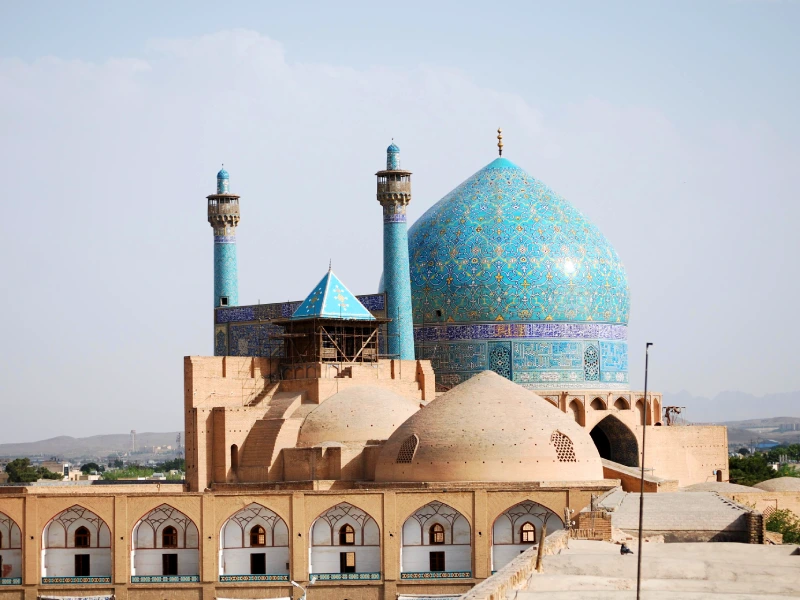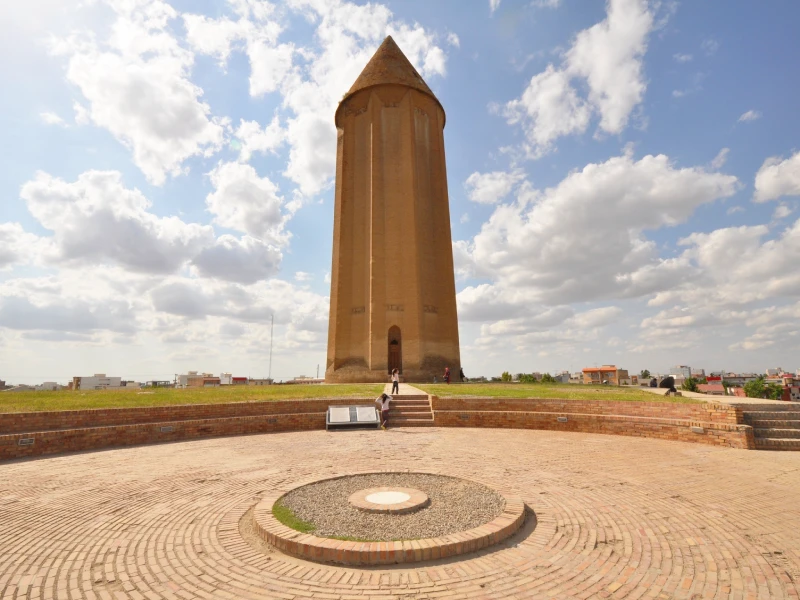Persian Blue Domes of Iran (History, Architecture, Types)
The Persian Blue domes of Iran are architectural marvels that show the creativity and artistic brilliance of Persian craftsmanship. For eras, these domes not only symbolize the rich cultural and historical heritage of Iran but also reflect the advanced engineering techniques and aesthetic sensibilities of the eras they were constructed in.
From the magnificent mosques of Isfahan to the timeless beauty of ancient mausoleums, Persian domes are characterized by their intricate tile work, geometric patterns, and harmonious proportions, showcasing their enduring legacy in Persian architecture. Let’s learn more about the Persian Domes of Iran.
Persian Domes History
The Persian Domes’ History dates back to ancient times, with their origins deeply rooted in the architectural advancements of the Persian Empire. Initially, these domes were constructed using simple techniques, but over time, they evolved into complex and stunning structures.
The Sassanian period, in particular, marked a significant development in Persian domes history, as architects began to experiment with larger spans and more elaborate designs. The use of squinches and pendentives allowed for the seamless transition from square bases to circular domes, setting a precedent for future Islamic architecture.
As Islamic influence spread across Persia, the Persian dome saw further evolution during the Seljuk and Safavid dynasties. These periods witnessed the incorporation of intricate tile work, calligraphy, and geometric patterns, which became defining features of Persian domes.
The domes not only served religious purposes in mosques but also adorned palaces and mausoleums, reflecting the aesthetic and spiritual values of the time. Throughout the centuries, Persian Dome history has continued to inspire and influence architectural styles across the Islamic world, showing how Persian art and innovation have made a lasting impact.
Blue Domes of Iran History
The blue domes of Iran, often seen adorning the country’s mosques and mausoleums, are a significant symbol of Persian architecture. These domes, typically glazed in turquoise or cobalt blue tiles, date back to the Seljuk era (11th-14th centuries) and reached their zenith during the Safavid period (16th-18th centuries). The vibrant blue color symbolizes heaven and spirituality, enhancing the sacred atmosphere of religious sites. Notable examples include the Shah Mosque in Isfahan and the Goharshad Mosque in Mashhad, where these domes reflect Iran’s architectural ingenuity and its deep cultural and religious heritage.
Persian Domes Architecture
The Persian dome architecture is super famous for its incredibly detailed design and amazing engineering. It’s a cool mix of artistic creativity and really smart building techniques. One of the most distinctive features of Persian domes is the use of geometric patterns and vibrant tile work, which not only enhance the aesthetic appeal but also serve practical purposes such as weight distribution and thermal regulation.
The iconic double-shelled dome design, which is a key feature of Persian dome architecture, not only creates a visually stunning exterior but also provides an acoustically and aesthetically pleasing interior. This architectural brilliance has not only been appreciated but also imitated across the Islamic world, influencing numerous structures outside the borders of Iran.
Another key aspect of Persian dome architecture is the harmonious integration of form and function. The architects of the Persian Empire were masters at creating domes that were both structurally sound and visually captivating.
Persian architects showed off their skills by using techniques like squinches and muqarnas to switch from square bases to circular domes. Moreover, the placement of domes in religious and public buildings not only symbolized the heavens but also provided large, open spaces that were essential for congregational gatherings. The enduring beauty and technical brilliance of Persian dome architecture continue to inspire modern architects and remain a proud testament to Iran’s rich cultural heritage.
Types of Domes
When exploring the various types of domes, it’s fascinating to observe the diversity and creativity that different cultures have brought to dome construction. One of the earliest types of domes is the simple corbel dome, which uses overlapping stones or bricks to create a self-supporting structure. This method can be seen in ancient buildings such as the Ruins of a Zoroastrian Temple in Neyasar. Another prevalent type is the true dome, which relies on a continuous curve to distribute weight evenly.
Among the many types of domes, the onion dome and the double-shelled dome are particularly notable. Onion domes, such as the Shah Cheraq Shrine in Shiraz, with a distinctive bulbous shape, add a unique visual flair to religious and public buildings. On the other hand, the double-shelled dome features an inner and outer layer, providing additional strength and allowing for grander designs.
Let’s add Persian Blue Domes to the main type of domes. Persian Blue Domes should be categorized as the most beautiful domes in Islamic architecture. The color blue exudes a profoundly positive aura, and gazing at it amplifies the positive vibes even further.
Each of these Types of Domes demonstrates how different architectural styles have evolved to meet both aesthetic desires and structural needs, reflecting the cultural and technological advancements of their times.
Blue Domes of Iran
When traveling to Iran, visiting the top domes is a journey through the country’s rich architectural legacy. The blue domes of Iran are among the most iconic and recognizable elements of Persian architecture, symbolizing the rich cultural and spiritual heritage of the region. These domes, adorned with intricate tilework and geometric patterns, crown mosques, shrines, and madrasas, reflect the artistic mastery and religious devotion of their creators. The deep, vibrant blue color, often associated with the heavens, creates a striking contrast against the arid landscapes of Iran, embodying both the infinite sky and the sacredness of the structures they adorn.
Start with the stunning Shah Mosque in Isfahan, renowned for its marvelous blue-tiled dome epitomizing Persian Islamic architecture. Another must-see is the Dome of Soltaniyeh, a UNESCO World Heritage site and one of the largest brick domes in the world, showcasing the ingenuity of Ilkhanid-era architecture. Goharshad Mosque in Mashhad has the bluest dome, built during the Timurid Dynasty. Shah Cheragh Shrine in Shiraz has an onion dome in a shade of blue that is so majestic to look at.
Lastly, the Jameh Mosque of Yazd, with its towering dome and minarets, might night be fully blue but it offers a glimpse into the architectural brilliance of the Seljuk and Safavid periods. Each of these domes reflects a unique aspect of Iran’s rich cultural and historical tapestry, making them essential stops on any tour of the country.
What is the oldest dome in Iran?
The oldest dome in Iran is believed to be the Gonbad-e Qabus, also known as the Qabus Dome, which dates back to the early 11th century. Constructed in 1006-1007 AD during the Ziyarid dynasty, this monumental structure is located in the Golestan province of northern Iran.
The Gonbad-e Qabus stands out with its towering height of about 53 meters, making it one of the tallest brick towers in the world. Its cylindrical shape tapers to a conical roof, showcasing early Persian engineering skills and architectural innovation. The dome is also renowned for its precise geometric design and inscriptions, reflecting the sophisticated artistry and technical prowess of its time.
Modern Persian Domes
Modern Persian Domes continue the rich tradition of Persian architectural innovation while incorporating contemporary design elements and materials. These structures often blend the classic beauty of traditional Persian domes with modern engineering techniques, resulting in domes that are both visually stunning and structurally advanced.
Architects of Modern Persian Domes frequently use materials like steel and reinforced concrete, allowing for greater flexibility in design and larger spans. These domes can be seen in a variety of buildings, from mosques and cultural centers to commercial and public spaces, showcasing the versatility and enduring appeal of this architectural form. The integration of advanced technologies with time-honored design principles ensures that Modern Persian Domes remain a prominent feature in Iran’s evolving architectural landscape.
Last Words
The Persian domes of Iran are exceptional architectural masterpieces that represent the country’s rich cultural and historical heritage. From the ancient Gonbad-e Qabus to the intricate designs of Isfahan’s mosques, these domes captivate the imagination and inspire awe. Their unique blend of artistic beauty and structural ingenuity makes them a must-see for anyone interested in architecture and history. We invite you to join our tours and experience the grandeur of these famous domes up close. Explore the vibrant history of Iran, where every dome tells a story of innovation, culture, and timeless elegance.
Are you planning to travel to Iran and looking for an Iran travel agency? Check out our Iran tours.









Leave a Reply
Want to join the discussion?Feel free to contribute!